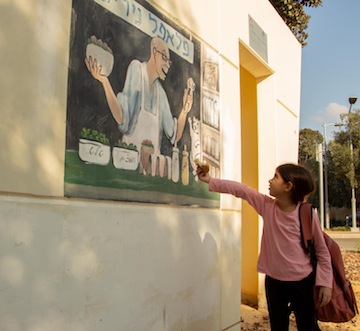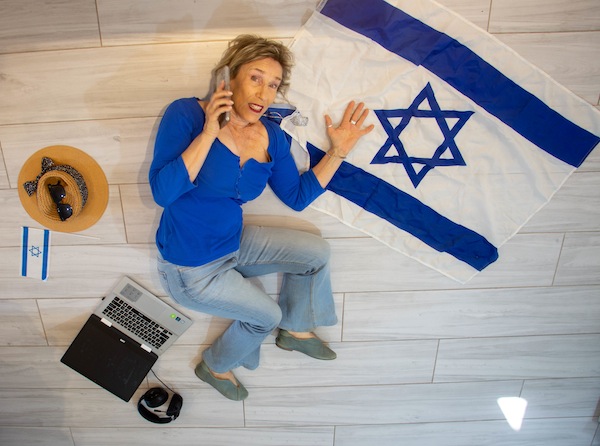Adele Raemer lives in Kibbutz Nirim, near the border with Gaza, which means the community has had to build safe rooms for protection from rocket attacks. (photo from Adele Raemer)
Tens of thousands of rockets have been fired regularly and indiscriminately at Israel from Gaza since 2001, and they continue. Adele Raemer is a community member of Kibbutz Nirim, just two kilometres from the Gaza border – so close that, she says, “there is zero to 10 seconds’ warning” of a rocket attack on her neighbourhood.
As spokesperson for the community, Raemer moderates a Facebook group called Life on the Border, about the kibbutz. She teaches English as a foreign language, and is a counselor for the Israeli Ministry of Education. In addition, she is a trained medical clown in the pediatric ward of the hospital in Ashkelon. She was invited in November 2018 to be on an independent investigative committee for the United Nations, to discuss living at the border, and, in December 2019, she addressed the UN Security Council. She has filed stories for CNN, particularly during the Pillar of Defence conflict in 2012.
While attending the Jewish Media Summit in Jerusalem this past December, the Jewish Independent spoke with Raemer.
JI: What compelled you to move to Nirim, and when was it?
AR: I came to Nirim [from the United States] in the framework of my army service in 1975. I fell in love with the community and decided to stay.
JI: At the summit, you mentioned a joint bike marathon with Gazans. Can you talk about that?
AR: I have been in touch with Rami Aman, a Palestinian from Gaza, for a number of years. He is one of the founders of the Gaza Youth Committee, a group of people who work with youth in Gaza in order to improve their quality of life and education, and to teach them that those who live on the other side of the border [Israelis] are not their enemies. One of the activities I participated in with them was a [joint] marathon. I am not able to discuss activities happening now, for the safety of my contacts. Unfortunately, doing activities such as these, on the other side of the border, can cost one one’s freedom, even one’s life.
JI: How did you get invited to speak at the UN Security Council in 2018?
AR: In light of the map of [Gazan-initiated] fires that I put together at the time, the interviews I gave to the media, my blogging and the Facebook group Life on the Border with Gaza, people in Israel who work with the American embassy turned to me. At the time, the U.S. were the hosts of the UN Security Council, and President Trump was interested in putting the situation in Israel in the spotlight.

JI: Nirim began building concrete safe rooms to protect against rocket fire. What is the ratio of safe rooms to homes, and how many people typically fit in one? What is the cost of a room?
AR: Each home typically has one safe room, about the size of a small bedroom, about nine square metres, and costs about $44,000. Safe rooms in people’s houses usually have beds in them, so, depending on how much furniture is in the room, it varies how many people fit in. Certainly the entire family will fit.
JI: How many casualties have there been in your community from rocket fire?
AR: Two members were killed in 2014 and, if I am not mistaken … fewer than 10 were wounded, mostly lightly. That, of course, does not take into account the many who have suffered psychological damage.
JI: Who is your member of Knesset, and how are they involved in ensuring the safety of the community?
AR: It doesn’t work that way – we do not have regional representatives, like you do. All of the MKs should be working towards the good of our communities. The current ministry for the development of the periphery of the Negev and the Galilee is Yitzhak Wasserlauf, but he has just taken office so I cannot say what he will be doing yet. The office itself has done the following in recent years: reinforced all schools within the Gaza envelope, developed Ale Negev [a rehabilitation hospital in the Negev] and programs for developing psychological support and resilience centres.
JI: You’ve said the kibbutz was “95% heaven.” Why do you feel that way?
AR: The region is a desert that has been made to bloom, a modern miracle of development, while protecting and preserving the nature and wildlife, despite multiple challenges including, but not only, security challenges. The community in which I live is not only beautiful but it is crime-free, and [it is] safe for children to play on the lawns, without worry of being run over or kidnapped. But, above all else, it is the sense of community – our kibbutz, as well as the other communities in the region, which support each other … make it a friendly, warm environment in which to raise families.
JI: What is the main industry of the kibbutz?
AR: Our kibbutz is mainly agricultural, so we have farmers and workers in the different branches that support the agriculture, but our people also work as professionals in all different professions, just like anywhere else in the world. We have doctors, nurses, lawyers, mechanics, teachers, social workers, chief cooks and bottle washers.
Dave Gordon is a Toronto-based freelance writer whose work has appeared in more than 100 publications around the world. His website is davegordonwrites.com.

